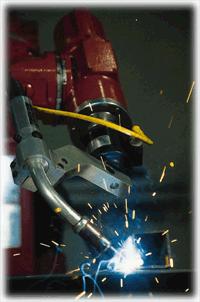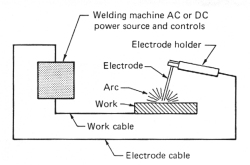Arc WeldingArc welding is a
method for joining two metal parts through melting themselves or welding wire
between them, using the heat generated from an arc of high electricity between
the parts and the tip of welding torch. The process may or
may not require the use of filler metal. The welding arc is struck between the
workpiece and the tip of an electrode. The electrode will either be a consumable
wire or a nonconsumable carbon or tungsten rod which carries the welding
current. When a nonconsumable electrode is used, filler metal can be supplied by
a spare rod or wire if needed. A consumable electrode, however, will be designed
not only to conduct the current that sustains the arc but also to melt and
supply filler metal to the joint. Arc Shielding One of the main problems when it comes to welding is that when metals heat up, they react chemically with the air. There are a lot of different methods for shielding the workpiece from the surrounding air. If the metal surface is protected from air by an inert gas this process is called Gas Metal Arc Welding (GMAW). Flux Cored Arc Welding (FCAW) is another process which is almost identical to GMAW except for the electrode. Using a granulated mineral material piled around the electrode as a flux in place of the gas gives Submerged Arc Welding. This technique is used for joint thicknesses as those found in high pressure tanks, heating plants' constituents, aqueducts and methane pipelines and the like. Gas Tungsten Arc Welding (GTAW), which is frequently referred to as TIG welding (Tungsten Inert Gas), and Plasma Arc Welding (PAW) are other commonly used welding techniques. Basic Welding Circuit An AC or DC power
source, is connected by a work cable to the workpiece and by a "hot"
cable to an electrode holder of some type, which makes an electrical contact
with the welding electrode. An arc is created across the gap when the energized
circuit and the electrode tip touches the workpiece and is withdrawn, yet still
with in close contact. The arc produces a temperature of about 6500ºF at the tip. This heat melts both the base metal and the electrode, producing a pool of molten metal sometimes called a "crater." The crater solidifies behind the electrode as it is moved along the joint.
|

